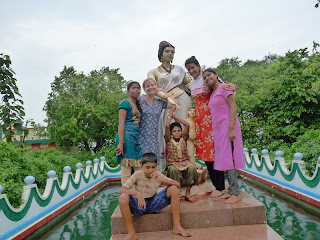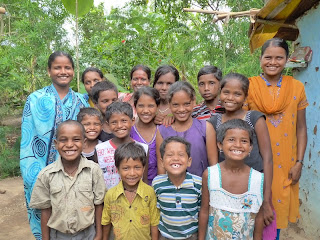I think because of our enthusiasm on the first day of Roja, Sue and I were invited by a new friend, Madhubhai, to visit his village outside of Bhubaneswar on Thursday, the final day of Roja. Sure, why not.
Plans in India are made slightly differently to what I am used to. I understood I would be called on Wednesday morning to confirm arrangements and that we'd be picked up on Wednesday evening, stay overnight in the village and have the whole day to participate in the festivities. On Wednesday night I was called about 8.30pm and told to be ready at 6.30am and wait for further instructions then. We were also told to pack bags to stay over Thursday night instead.
It all seemed to work out and by 9am we were on our way, Sue, Madhubai, me and a couple of young university students/volunteers, Mani and Abhilasha. The day was beautifully cool and drizzly and fantastic for a drive although I had a terrible cold that had set in which I was trying to ignore.
On the way to the village we visited two temples, one for Durga and one for Ganesh. In the first we lit candles and received blessings and it was a really special experience.
We arrived in Madhubhai's village in time for lunch and had that at his mum's home. He is a from a joint family so there were aunties and cousins and all sorts of relatives floating around.
The day ended up being pretty busy, visiting his family and friends and the old Buddhist remains at nearby Lalitgiri*.
In the evening we were taken to the centre of the village where there was a stage set up and a performance going on. This was something that occurs each year during Roja and it seems to me it is a cross between street theatre and preaching.
Due to the constant rain we abandoned plans to stay overnight which I was quite happy about as my cold had become worse and I was craving sleeping in my own bed. It was a really wonderful day in the end although very tiring. And of course, Sue and I have a few new friends (or family members)!
*Lalitgiri (also known as Naltigiri) is a Buddhist complex in Orissa comprising major stupas and monasteries, similar to Ratnagiri and, together with Ratnagiri and Udayagiri, part of Puspagiri University. Numerous excavations by the Archaeological Survey of India have been conducted since 1985, and continue to this day.
A museum is to be built to display relic caskets thought to contain bones of Gautama Buddha, and other archaeological finds for public display. The site was extensively excavated by the A.S.I. from 1985-92. The remains of a huge stupa, and relic caskets consisting four containers made of khondalite, steatite, silver and gold were discovered along with other important structure and archaeological remains.














